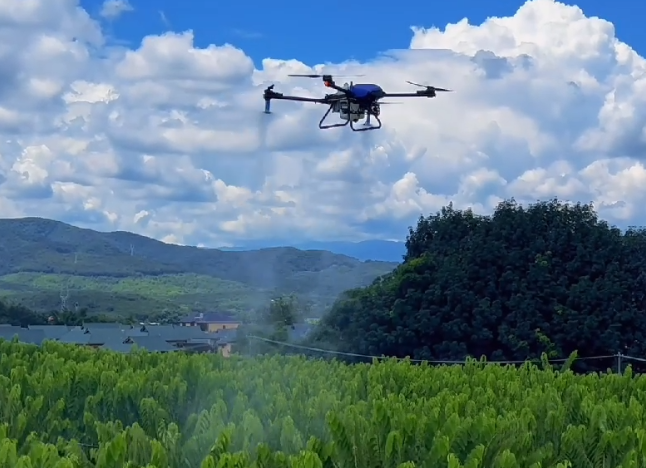The Application of Drones in Agriculture
Oct 27 , 2022The drones used in agriculture are usually called agricultural plant protection drones. They are mainly used for drones in agricultural and forestry plant protection operations. The spraying operation is realized through ground remote control or GPS flight control. powder, etc. Compared with traditional plant protection operations, UAV plant protection operations have the characteristics of precise operation, high efficiency, environmental protection, intelligence, and simple operation. In addition, due to the small size, light weight, convenient transportation, and flexible flight control of agricultural plant protection drones It has good applicability to various plots and crops, so its application prospect is very broad, and it has received extensive attention from the public in recent years.

There are many types of drones, and there are roughly two classification methods used in the agricultural field:
1) According to the power, it can be divided into oil-powered UAV (engine as power device) and electric UAV (motor as power device);
2) According to the model structure, it can be divided into fixed-wing rubber tree agricultural drone, single-rotor drones, and multi-rotor drones.
Fixed-wing aircraft are mainly used in farmland information collection and farmland remote sensing, and have the characteristics of large load, fast flight speed and high operating efficiency. When operating, it generally uses ultra-low altitude flight, 5-7 meters away from the crop canopy, and has high requirements for the terrain of the operating area, and is generally used in open farms.
The volume and load of single-rotor and multi-rotor UAVs are relatively small, flexible in operation, and high in operation efficiency. They are suitable for operation in relatively scattered farmland blocks, and have strong practicality in the vast rural plant protection operations in my country. sex.
At present, the application of banana agricultural drone in agricultural production has achieved initial results, which are mainly reflected in the following six aspects
1. Plot and soil analysis Agricultural drones equipped with high-definition cameras and advanced sensors can draw accurate three-dimensional maps of plots and soil analysis, and make detailed planning for planting, which plays a crucial role in the initial stage of agricultural production. important role. At the same time, agricultural drones of this type can also closely monitor the condition of the plot, providing powerful data support for later irrigation and soil nitrogen content management.
2. Aerial seeding Scientists racked their brains to develop a complete drone seeding system. The system simultaneously infuses the soil with seeds and all the nutrients they need to grow. This technology increases the nutrient absorption rate of seeds by 75%, while reducing the cost of sowing by 85%. It not only ensures the survival rate of seeds, but also relatively reduces the consumption of other resources, which can be said to kill two birds with one stone.
3. Spraying operation Agricultural drones equipped with ultrasonic, radar and advanced spraying systems are widely used in plant protection operations, and are also commonly known as plant protection agricultural drone for banana. This type of UAV can continuously adjust the flight height according to the geographical terrain, identify and avoid obstacles autonomously, and rely on the advanced spraying system to carry out accurate and uniform spraying operations on crops. This technology greatly reduces the amount of pesticides and reduces the pollution of plant protection operations to water bodies and the environment. Experts estimate that compared with traditional machinery, plant protection drones have up to five times the operational efficiency, which will greatly reduce the consumption of manpower and material resources.
4. The large plot of crop monitoring and the low efficiency of crop monitoring are another major pain point in agricultural production. As global temperatures rise and climate change becomes increasingly erratic, it becomes increasingly difficult to manage and maintain land parcel conditions. In the past, farmers mainly relied on satellite images to assist crop monitoring, but the cost was too high and pre-purchased in advance, and the service efficiency of one piece per day was difficult to provide real-time and accurate crop monitoring information. Agricultural drones equipped with real-time imaging systems have emerged, providing farmers with a reliable and effective guarantee for more accurate monitoring of crop growth conditions and timely and effective prevention and control measures.
5. Agricultural UAVs equipped with hyperspectral, multispectral and thermal sensors can accurately analyze and identify the arid areas of the plot, providing powerful data support for precision irrigation operations. In addition, during the growth of crops, this type of drone can also calculate the vegetation index, and analyze the density and health of crops through the heat emitted by the crops themselves.
6. Crop health assessment It is one of the necessary guarantees for high-quality agricultural production to conduct health assessment of crops and timely detection of pests and diseases. By equipped with visible infrared and near-infrared emission equipment, agricultural drones can accurately analyze the amount of green and near-infrared light reflected by crops and draw multi-spectral images to track changes and health conditions of crops. Farmers can make fast and effective prevention and control measures based on the corresponding data to protect crops from pests and diseases, thereby significantly improving the efficiency of agricultural production.